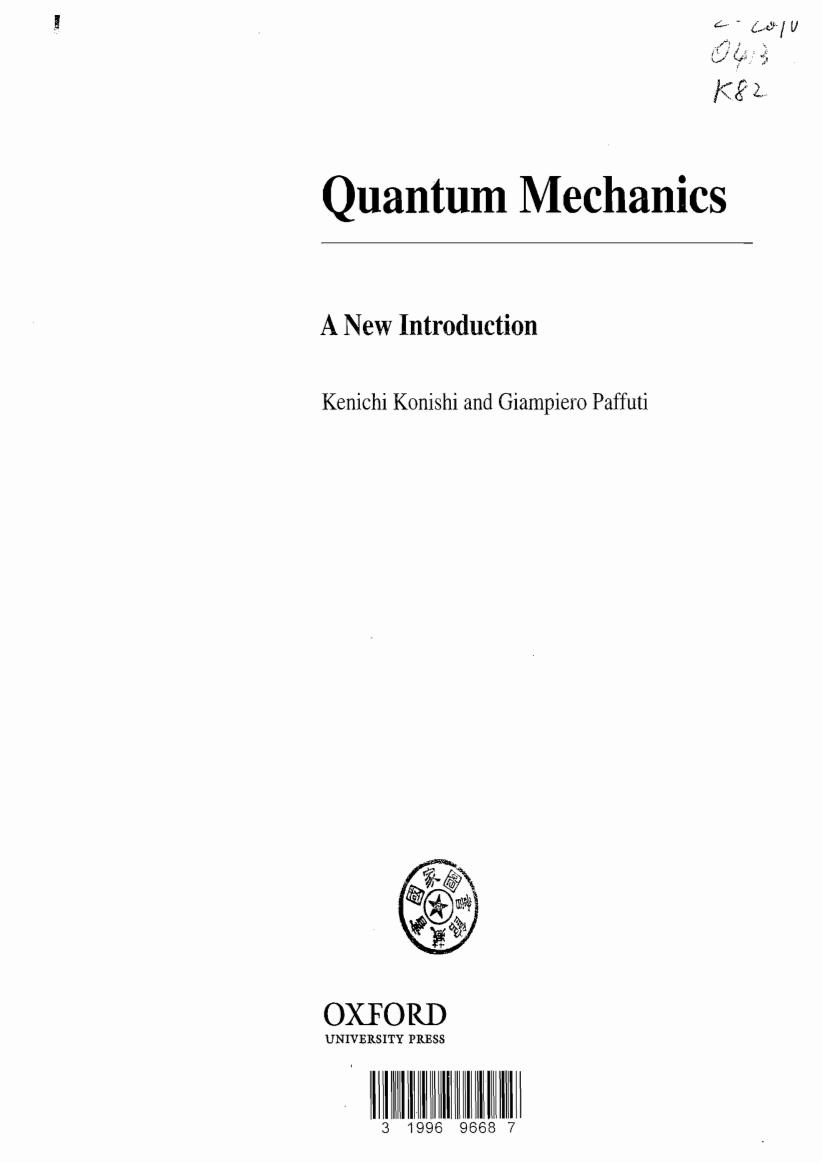
#c010 0413 K82 Quantum Mechanics A New Introduction Kenichi Konishi and Giampiero Paffuti OXFORD UNIVERSITY PRESS 3199696687

OXFORD UNIVERSITY PRESS Great Clarendon Street,Oxford OX26DP Oxford New York A oaveny First published 2009 means. British Library Cataloguing in Publication Data Data available Library of Congress Cataloging in Publication Data Data available 1) 10987654321
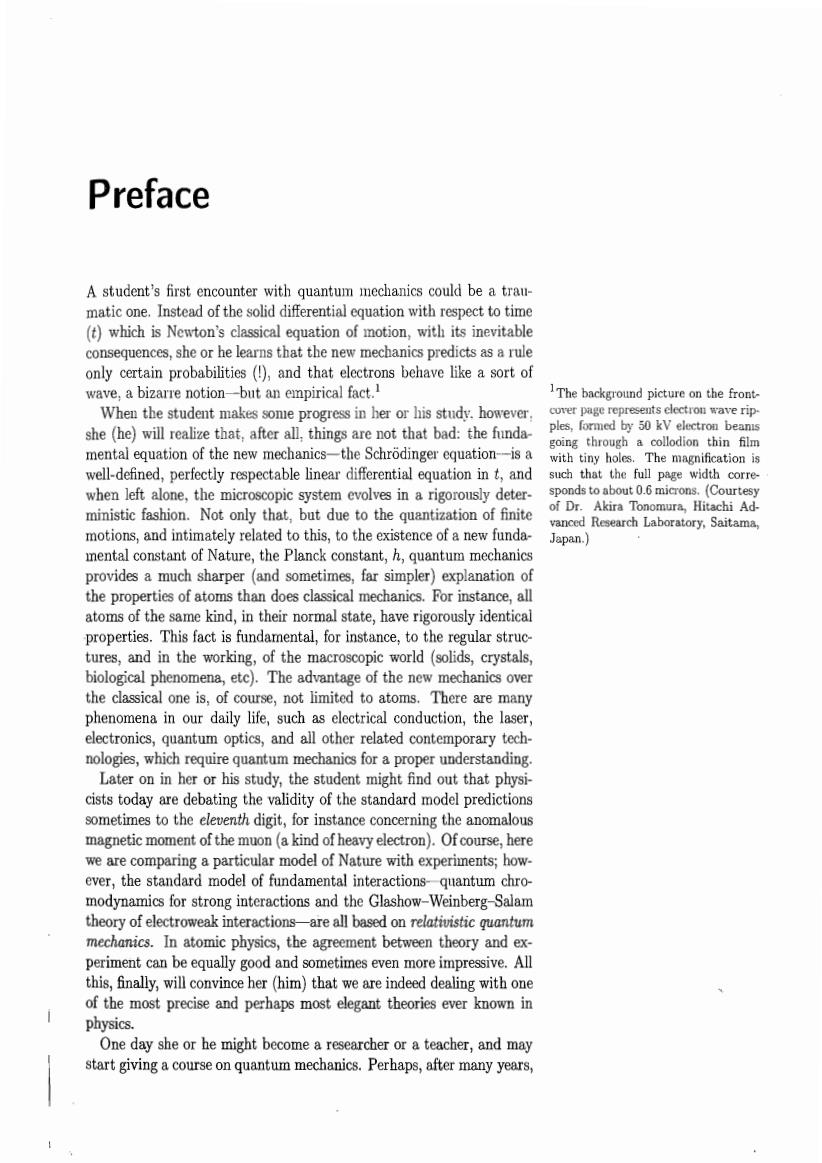
Preface A student's first encounter with quantum mechanics could be a trau Instead of the solid ith respect totim with its evitable she h S p (and tha s as a rule ons behave like a sort o arre notion- The she(he)will realize that,after all,things are not that bad:the fiunda ples.o mental equation of the new mechanics-the Schrodinger equation-is a with tiny hales The magn well-defined,perfectly respectable linear differential equation in t,and when left alone,the microscopic system evolves in a rigorously deter- ministic fashion.Not only that,but due to the quantization of finite of Dr. Akira Ton ra,Hitachi Ad motions,and intimately related to this,to the existence of a new funda- mental constant of Nature,the Planck constant,h,quantum mechanics provides a much sharper (and sometimes.far simpler)explanation of the properties of atoms than does classical mechanics.For instance,all atoms of the same kind,in their norma state,have rigorously identical properties.This fact is fundamenta,for instanc, tures and in the working of the macros world (solids.crystals biological phe na ete)Th age of the new mechan s ove the class 1 one is,of c ot lim ited to nomena in our dlectricaleol the la optics relate contem m mecha cs fo ater on or his study. the stu nt might分 tha physi cists today ar ating the validity of the standard model predictions sometimes to the eleventh digit,for instance the anomalous magnetic moment of the muon (a kind of heavy electron).Of course,here we are comparing a particular model of Nature with experiments:how ever.the standard model of fundamental interactions-quantum chro modynamics for strong interactions and the Glashow-Weinberg-Salam theory of electroweak interactions-are all based on relativistic quantum mechanics.In atomic physics,the agreement between theory and ex periment can be equally go ood and sometimes even more impressive.All this.finally will convince her (him)that we are indeed dealing with on of the most precise and perhans most elegant theories wn in On e day she or he might becom ra teacher,and may tart giving a course on quantum me Perhaps,after many years
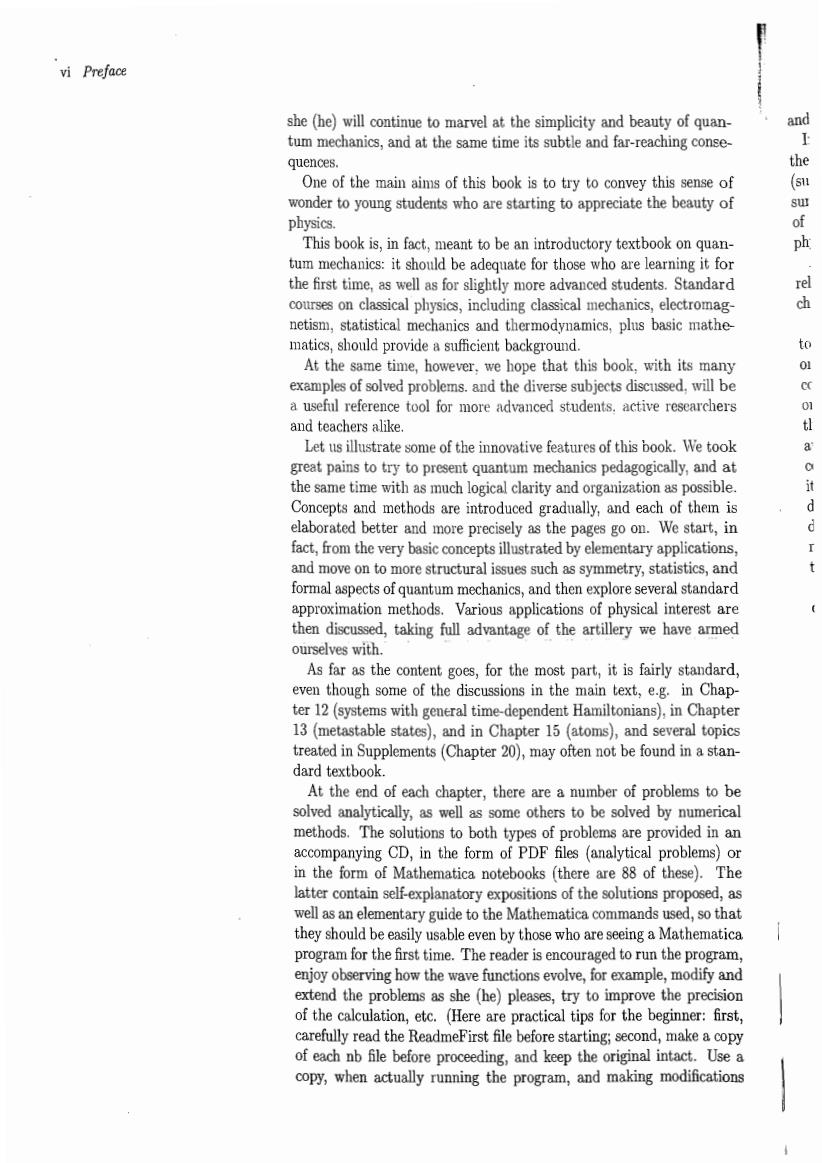
vi Preface she (he)will marvel at the simplicity and beauty of quan and tum mechanics,and at the same time its subtle and far-reaching conse the- One of the main aims of this book is to try to convey this sense of wonder to young students who are starting to appreciate the beauty of physics. of This book is,in fact,meant to be an introductory textbook on quan ph tum mechanics:it should be adequate for those who are learning it for the first time,as well as for slightly more advanced students.Standard courses on classical physics,including classical mechanics,electromag- netism,statistical mechanics and thermodynamics,plus basic mathe matics,should provide a sufficient background. to At the same time.how er we bop that this book with its many and the dive e subjects discussed,will be rcher and teachers alike Let us illustrate ome of the innovative feat s of this book.We took pe 0g10 has much logical clarity an methods are introduced gradually,and eac them is We start,in from the very basic concepts illustrated by elementary applications and move on to more structural issues such as symmetry,statistics,and formal aspects of quantum mechanics,and then explore several standard approximation methods.Various applications of physical interest are then discussed.taking full advantage of the artillery we have armed ourselves with. As far as the content goes,for the most part,it is fairly standard, even though some of the discussions in the main text,e.g.in Chap- ter 12(systems with general time-dependent Hamiltonians),in Chapter 13 (metastable states),and in Chapter 15(atoms),and several topics treated in Supplements(Chapter 20).may often not be found in a stan dard texthook At the end of each chapter,there are a mumber of problems to be solved analvticallv to be solved by 。to both typ prov ided in form s(analy The in self-explanatory expos as an e mentary guide to the Mathematica commands u so that they should be easily usable even by those who are seing a Mathematica program for the first time.The reader is encouraged to run the program, enjoy obeerving how the wave functions evolve,for example,modify and extend the problems as she (he)pleases,try to improve the precision of the calculation,etc.(Here are practical tips for the beginner:first, carefully read the ReadmeFirst file before starting;second,make a copy of each nb file before proceeding,and keep the original intact.Use a copy,when actually running the program,and making modifications

n and extensions.】 In some cases the analysis is pushed a little deeper into the heart of tion: the study of metastable sy r gener al elements etc.),bu ys in a concrete phys atic all,this is meant but at the same tim relatively self-contained and comprehensive,textbook on quantum me- chanics. The book is organized as follows.Part I is an elementary introduction to the basics of quantum mechanics.Together with some initial sections on perturbation theory and variational methods in Part II,Part I could correspond to standard material for an introductory semester course on quantum mechanics in most universities.Part II is dedicated to the three standard methods of approximation,perturbation theory.the vari- ational method,and the semiclassical approximation,through which the concepts in the theory are further developed and the range of applicabil. ity vastly increased.In Part III the formalism and methods of analyses dep ndent Ham tonians,general discussions of met stems,the ion of electrically ch agneticields,atoms and el PartIVsdBdicatedtotwofndanentalisy ment and the me is 10 natures,ranging fr a review of es,to some advanced topics,techni and mathematical appendices.The are independent of each other there is no ordering among them,and many are even independent of the main text,so that each of them can be read at leisure in a convenient moment for each reader. an- The accompanying CD,as already anticipated,contains the Mathe matica notebooks and PDF files in which the problems proposed at the be end of each chapter are solved and discussed.The subfiles for each chap- ical ter contain all the notebooks of that chapter,accompanied by a file called an Guide-to-NB.nb.In this file a list of all the Mathematica notebooks of r that chapter is given,as well as a brief description of each notebook.All Th analyses have been done by using Mathematica 6.Wolfram Research and t ested with Mathematica 7,which has just come out. hat updates and http://www.df.uipi.it/-konish http://www.df.unipi.it/-paffuti opy English and for his inv the the responsibilityf any errors ext o os,for ny mislea s,whic ch may undo remain or might have been introduced during the course of corrections

vii Preface ours and ours only,Thak are de to Chrlote Gree of OUP er crisp approa to edn al help,and to Sor the senior phyaicsedtor,iorhisadnirablepetiercediringthisbokslongperiod of gestation. Our hearty gratitude goes toour friends and colleagues who helped us C at various moments and in various-small and big-ways.A short list includes:A.Bonaccorso,D.M.Brink,P.Calabrese,P.Cecchi,R.Col- lina,E.D'Emilio,A.Di Giacomo,G.Dunne,T.Elze,M.Fukugita,C. Giannessi,V.Gracco,R.Guida,R.Jackiw,F.Maccarrone,G.March- esini,M.Matone,P.Menotti,M.Mintchev,F.M.Miranda,G.Morchio, E.Onofri,L.Picasso,M.Rocca,S.Shore,A.Toncelli,M.Tonelli,A. 1月 Tonomura,P.Truini,A.Vainshtein,and G.Veneziano. A final message to all of you(especially to the young) Read and Enjoy! Pisa,February 2009 K.Konishi and G.Paffuti

Contents I Basic quantum mechanics 1 1 Introduction 1.1 The quantum behavior of the electron 1.11 Diffraction and interference visualizing the quan 1.1.2 The and identity of atoms 13 12 tum mechanic 80 From the theory of specific heat to Planck's formula 9 132 The photoelectric effect 14 1.2. Bohr's atomic model 1.2.4 The Bohr-Sommerfeld quantization condition: de Broglie's wave Further reading 18 Guide to the Supplements 18 Problems 19 Numerical analyses 2 Quantum mechanical laws 2.1 Quantum states 21 2.1.1 Composite systems 24 2.1.2 Photon polarization and the statistical nature of mechanics 24 22 The ur princip 26 2.3 The fundame 23 Theprojlectionoperatoramdstatevectorredtction 3 He oductsof operators,commutators,and compat- ible observables 2.3.4 The position operator,the momentum operator, fundamental commutators,and Heisenberg's rela- tion 3 2.3.5 Heisenberg's relations 2.4 The Schrodinger equation 37 2.4.1 More about the Schrodinger equations 3 2.4.2 The Heisenberg picture 40 The continuous spectr 40 951 The delta function 41 2.52 Ort
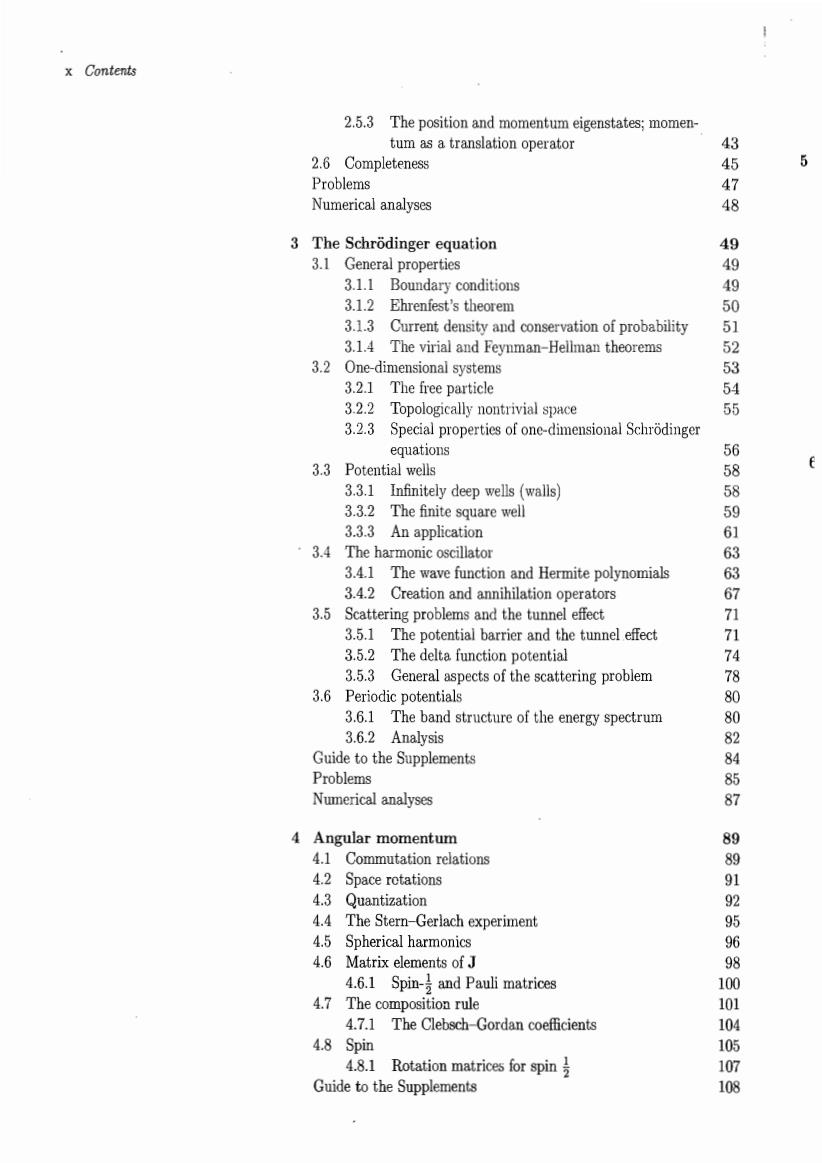
x Contents 2.5.3 The position and momentum eigenstates;momen- tum as a translation operator 2.6 Completeness 45 5 Problems 47 Numerical analyses 8 3 The Schrodinger equation g 3.1 General properties 3.1.1 Boundary conditions 49 3.1.2 Ehrenfest's theorem 3.13 Current density and conservation of probability 3.1.4 The virial and Feynman-Hellman the 52 3.2 One-dime 54 Topologically nontrivial 5 3.2.3 Special properties of on-dimensional Schrodinger equations 3.3 Potential wells 3.3.1 Infinitely deep wells(walls) 58 3.3.2 The finite square well 3.3.3 An application 可 3.4 The harmonic oscillator 63 3.4.2 Creation and annihilation 3.5 Scatterin and the 3.5.1 the t unnel effect 352 potentia 74 35.3 General aspects of the scattering problem 3.6 Periodic potentials 3.6.1 The band structure of the energy spectrum 80 3.62 Analysis 82 Guide to the Supplements Problems 8 Numerical analyses 4 Angular momentum 89 4.1 Commutation relations 4.2 Space rotations 4.3 Onantization 4.4 The Stern-Gerlach experiment Spherical harm Matrix e 4.6.1 4.7 The composition rule 101 4.7.1 The Clebsch-Gordan coefficients 4.8 Spin 105 4.8.1 Rotation matrices for spin Guide to the Supplements 108
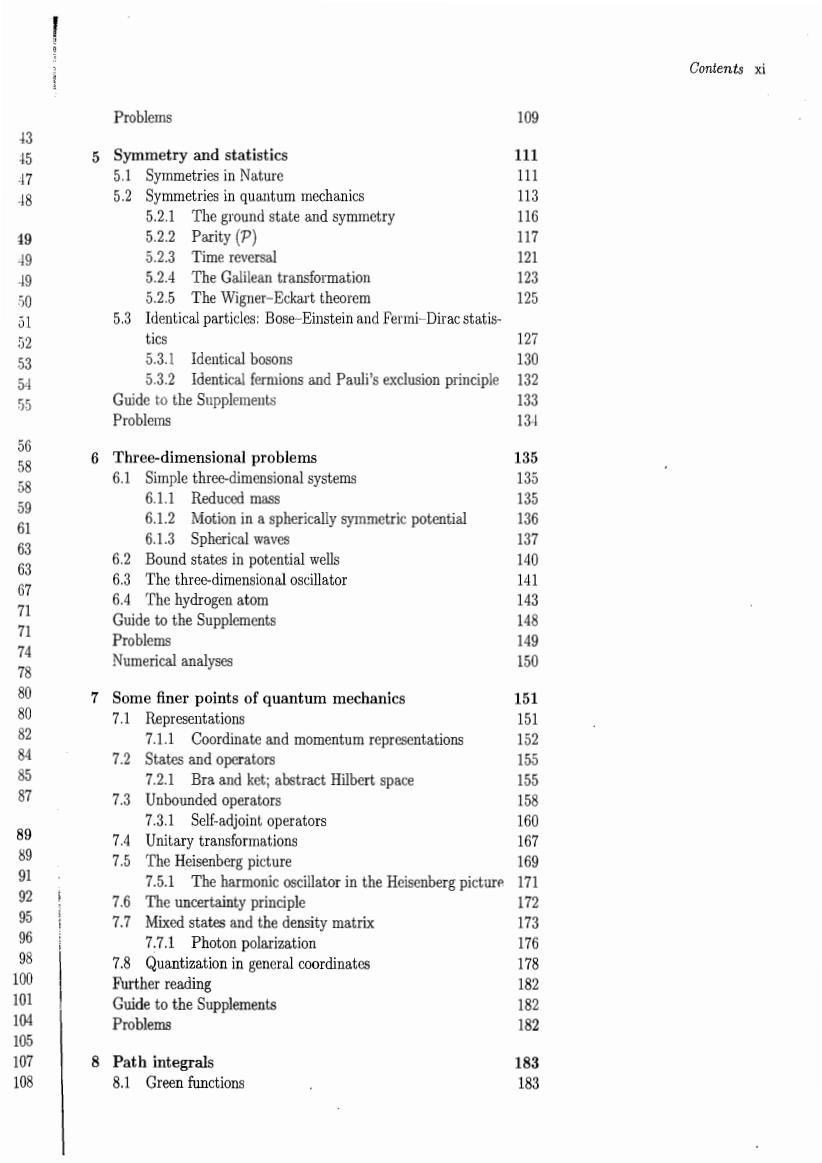
Contents xi Problems try and statistics 47 es in Nature 6 es in quantum mechanics 5.2.1 The ground state and symmetry 49 5.2. Parity (P) 5.2.3 Time reversal 1 9 5.2.4 The galilean transformation 123 5.2.5 The Wigner-Eckart theorem 125 5.3 Identical particles:Bose-Einstein and Fermi-Dirac statis- tics 127 5.3.1 Identical bosons 130 5.3.2 Identical fe rmions and Pauli's exclusion principle Guide to the Supplements Problems 131 6 Three-dimensional problems 135 58 6.1 Simple three-dimensional systems 6.1.1 Reduced mass 135 6.1.2 Motion in a spherically symmetric potential 136 6.1.3 Spherical wat 6.Bound states in po 6.3 tentialels The three-dimen roge Supplement Numerical analyses 7Some fner pointsfq mechanics 7.1 at 4 Coordinate and momentum representations 7.2 s and operators 5 7.2.1 Bra and ket;abstract Hilbert space 7.3 Unbounded operators 7.3.1 Self-adjoint operators 8 7.4 Unitary transformations 7.5 The Heisenberg picture 169 7.5.1 The harmonic oscillator in the Heisenberg picture 1 7.6 The uncertainty principle 172 7.7 Mixed states and the density matrix 173 7.7.1 Photon polarization 7.8 Quantization in general coordinates 10 Further Supplements Problems 8 Path integrals Gre 183

xii Contents 82 Path integrals 11T 8.2. Derivation 822 Mode expansion 8.2.3 Feynman graphs 8.2.4 Back to ordinary (Minkowski)time 8.2.5 Tunnel effects and instantons 198 Further reading 201 Numerical analyses 202 II Approximation methods 203 9 Perturbation theory 9.1 Time-independent perturbations 011n generate levels 212 9.1.2 The Stark effect on the=2level of the hydroger 9.13 Dipoleinteractionsandpolarizabhlty 9.2 Quantum transitions 92.1 Perturbation lasting for a finite interval 9.2.2 Periodic perturbation 9.2.3 Transitions in a discrete spectrum 223 9.2.4 Resonant oscillation between two levels 225 9.3 Transitions in the continuum 226 12 9.3.1 State density 228 228 9.5 omagnetic transitions The dipole oximation diation (or stimulated)emission Spontaneous emission 9.6 The Einstein coefficients Guide to the Supplements 湖新源幼4422 Problems Numerical analyses 244 10 Variational methods 245 10.1 The variational principle 10.1.1 Lower limits 10.1.2 Truncated Hilbert space 249 10.2 Simple applications 10.21Te 1022H oscilator elementary variational calculatior 10.2.3Ths virial 10.3 The ground state of the helium Guide to the Supplements Problems Numerical analyses 262